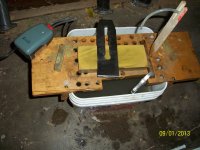Hand sharpening isnt as difficult as you think. Here is a video from Paul Sellers sharpening a $10 set of chisels to perfection using sandpaper and a strop. He uses diamond stones day in and day out, but to get started you really dont need much. I use his technique and I can tell you it is very fast, and very effective with little to no learning curve. He demonstrates his technique in another video for plane irons as well. I use the diamond plates but I dont even use a leather strop. Just a piece of wood that I rub chromium oxide on. Very, very sharp result in about 2 minutes and, if you strop every little bit while you are working, you dont need to do a big sharpening for some time, even when putting the tools through a lot of work.
At any rate, a much cheaper method (~100 dollars for diamond plates, a scrap piece of glass for initial flattening, and glass cleaner as lapping fluid), which leaves you with much more $ to spend on Festool. I am a novice, and I learned this method in about 20 minutes, and my tools are incredibly sharp.
Edit: forgot to include link.

